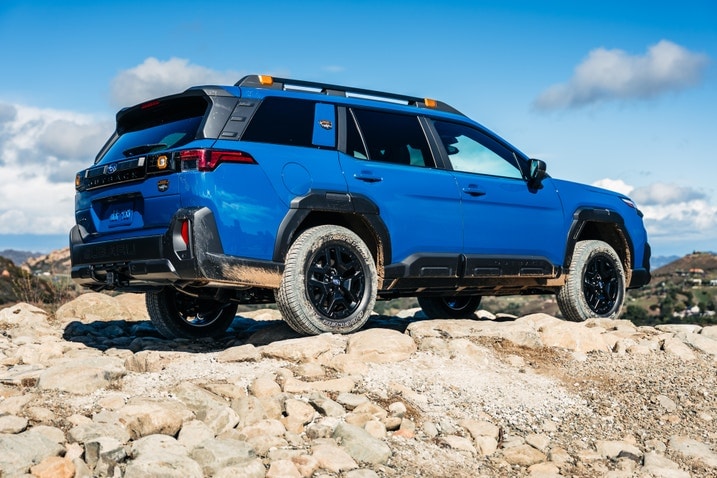- Subaru's all-new 2026 Subaru Outback Wilderness offers 9.5 inches of ground clearance and the promise of being the most capable Outback ever.
- Toyota's Land Cruiser is a traditional off-roader with more power and body-on-frame construction, but less ground clearance.
- Can a car-based SUV compete with a true off-road legend?
Subaru Outback Wilderness vs. Toyota Land Cruiser: Off-Road Specs Compared
Can a car-based SUV compete with a body-on-frame legend? Subaru thinks so
Subaru is trying hard to convince potential buyers that its new Outback and Outback Wilderness are SUVs. Not cars, SUVs. If so, the latest Subaru should be able to compete — on paper, at least — with an iconic SUV known for doing the things Subaru claims its new Outback Wilderness can do. You know, things like crawling up loose, rocky trails, traversing sand washes and edging along sandstone cliffs. Toyota’s Land Cruiser, which is significantly more expensive, does all those things. Here’s a closer look at the specs and the merits of each.
Full details haven’t been released yet on the new Outback, so some of these specs are based on what was said at the new Outback’s reveal at the New York Auto Show (Edmunds' estimates will be noted in the chart below). But there’s enough hard data to draw some conclusions.
Spec comparison: 2026 Subaru Outback Wilderness vs. 2025 Toyota Land Cruiser
Engine | turbocharged 2.4-liter flat four-cylinder | turbocharged 2.4-liter inline four-cylinder, electric motor |
|---|---|---|
Horsepower (SAE hp) | 260 hp | 326 hp |
Torque | 277 lb-ft | 465 lb-ft |
Transmission | CVT (eight simulated gears) | eight-speed automatic |
Four-wheel-drive system | full time | full time |
Low range | no | yes, 40.6:1 crawl ratio |
Locking differentials | center | center, rear |
Ground clearance | 9.5 inches | 8.7 inches |
Breakover angle | 21.3 degrees | 23 degrees |
Approach angle | 20 degrees | 32 degrees |
Departure angle | 22.5 degrees | 22 degrees |
Wheelbase | 110.1 inches (est.) | 112.2 inches |
Overall length (inches) | 191.9 inches (est.) | 193.8 inches |
Overall width (inches) | 75.6 inches (est.) | 77.9 inches |
Overall height (inches) | 68.9 inches (est.) | 76.1 inches |
Curb weight (pounds) | N/A | 5,038 pounds |
Cargo volume behind second row/max | 34.6 cu ft/NA | 46.2 cu ft/82.2 cu ft |
Max towing capacity | 3,500 pounds | 6,000 pounds |
The Outback Wilderness is powered by a 2.4-liter turbocharged flat four-cylinder engine that produces 260 horsepower and 277 lb-ft of torque. That’s a lot less output than the Land Cruiser offers, but it’s also pushing around a lot less car, er, SUV. The 2025 Outback Wilderness weighed 3,922 pounds — a number that’s sure to increase because the rest of its dimensions did for 2026. Subaru says the new version is about 2 inches taller, 1 inch wider and 0.5 inch longer. But even accounting for a heavier Outback, the Cruiser is a relative porker at 5,038 pounds.
The Outback’s engine is paired with a continuously variable transmission and a full-time all-wheel-drive system capable of automatically locking the center differential. Subaru’s X-Mode provides two drive modes that optimize the powertrain for differing surfaces. Electronically controlled dampers are standard, as are 17-inch wheels that are wrapped in Bridgestone Dueler all-terrain tires. Subaru hasn’t said what size they are, but the previous Outback Wilderness wore 225/65R17 Yokohama Geolandar rubber.
At 9.5 inches, the new Wilderness has the same ground clearance as the outgoing model so it seems safe to assume it has a similar amount of tire sidewall. The outgoing model also had a four-wheel independent suspension — struts up front and a multilink setup out back. We don’t expect that to change, but Subaru hasn’t shared details yet.
The 2025 Outback Wilderness will set you back $39,960 to start. We expect to see a modest price increase for the 2026 model, but it will still be far less expensive than the Land Cruiser.
And the Toyota, for its part, has all the makings of a traditional SUV. Tall and boxy, it’s built around Toyota’s GA-F platform, which uses body-on-frame construction that it shares with the Tacoma and other Toyota products. Its rear axle is coil-sprung and it uses an independent double-wishbone suspension up front. Still, this more traditional off-road hardware only gives it 8.7 inches of ground clearance, less than the Outback Wilderness. But its breakover and approach angles both exceed those of the Subaru. Departure angles are a near wash.
Under the hood, the Toyota offers a turbocharged hybridized four-cylinder good for 326 horsepower and 465 lb-ft of torque. Torque is routed to all four wheels via an eight-speed automatic transmission and a two-speed transfer case. The power coupled with a ladder-style frame yields a 6,000-pound maximum tow rating — far exceeding the Subaru’s more modest 3,500-pound rating.
Additionally, the Cruiser offers off-road hardware like locking center and rear differentials and a disconnecting front stabilizer bar for increased wheel articulation.
Somewhat ironically, last year’s Outback Wilderness, which shares the 2026 model’s powertrain and output, earned the same EPA-estimated mpg as the hybridized 2025 Land Cruiser. Both are rated at 23 mpg combined. We expect the 2026 Outback, given its size increase, to do slightly worse.
The 2025 Land Cruiser starts at $56,700. That means you’ll probably be able to buy a 2026 Outback Wilderness and a nice trip to the actual Outback for what you’ll spend on a Land Cruiser.
The Outback, no matter how Wilderness-y Subaru makes it, is always going to be a car-based SUV. And even with real ground clearance, it’s going to have a hard time with off-road scenarios that a Land Cruiser won’t even consider a challenge. Only you can decide whether those things are worth its price premium.







 by
by  edited by
edited by